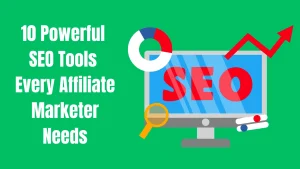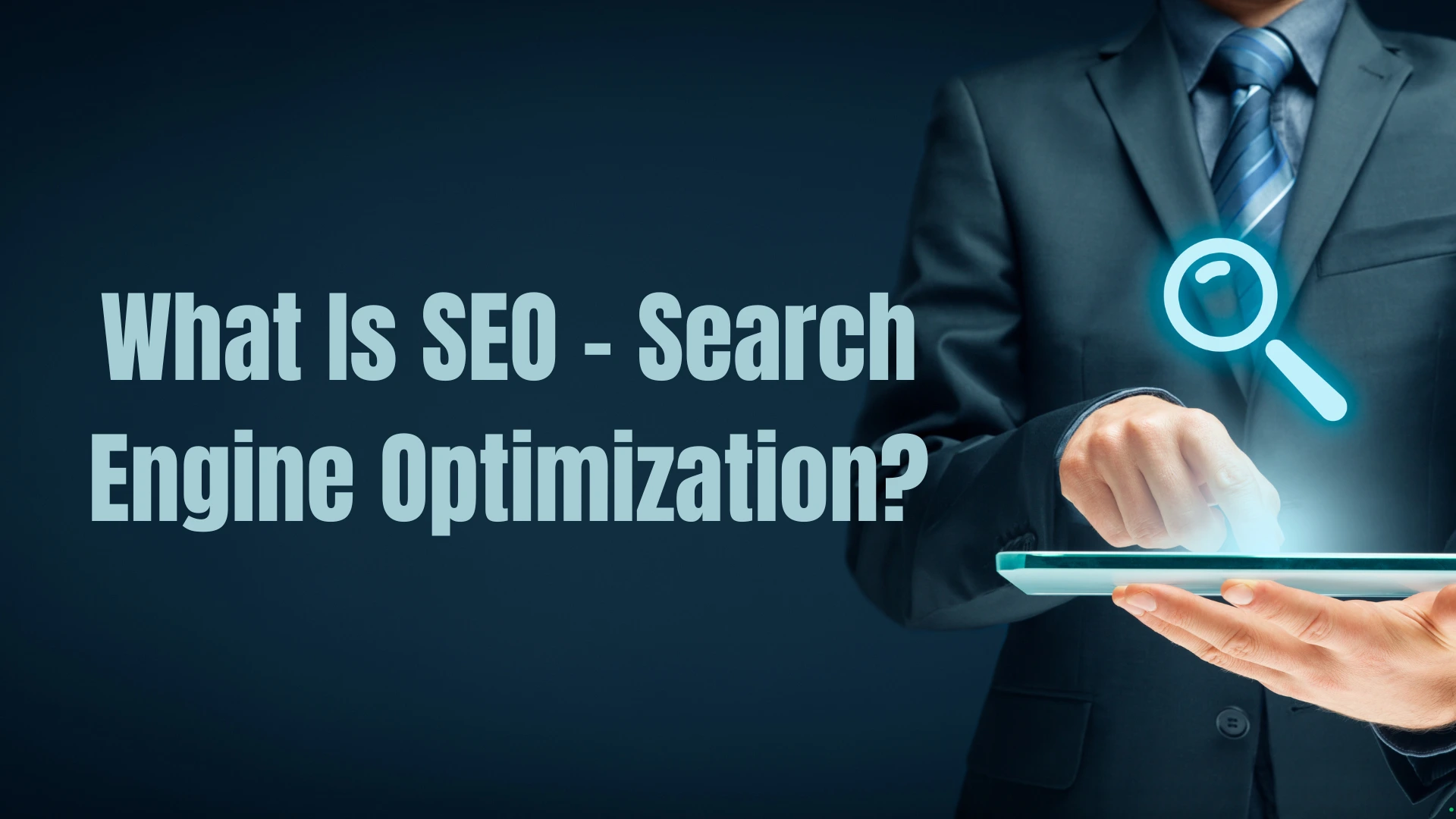
Why do certain websites top search results while others make an impact? The answer can be found in the power of search engine optimization, or SEO.
In the online world, SEO is the key ingredient that helps websites boost their visibility, draw in visitors, and expand their audience.
SEO doesn’t just aim to increase traffic; it focuses on attracting the right traffic. Picture it as a matchmaking service between your website and people looking for what you provide. With more than half of all website traffic coming from organic searches, getting good at SEO isn’t just a nice extra; it’s essential.
A good SEO plan doesn’t just boost your rankings. It creates trust, keeps readers interested, and brings real results. As technology continues to evolve, the level of expectation rises. The worldwide SEO market is set to go over $120 billion in the next few years.
In this guide, we’ll break down the basics of SEO, look at why it matters so much in online marketing, and give you useful tips to help you reach the top of search results and stay there. Let’s begin!
Want to stay ahead in search rankings? Learn SEO and rank at the top of Google with SEO 2025—beginner to advanced!
Key Takeaways
- SEO is key for driving organic traffic to websites.
- A solid SEO strategy boosts visibility in search results.
- The SEO industry is set to grow a lot in the future.
- Grasping SEO can set successful businesses apart online.
- Organic search is a big part of website traffic.
Understanding SEO: What Does It Mean?
In simple terms, Search engine optimization is the process of making changes to your website so that search engines like Google can find it easily and rank it higher in search results.
It involves tweaking things like the content, layout, and performance of your site so that search engines can easily find it, understand what it’s about, and show it to the right people when they search for something related to your business.
The goal is to get your site to show up higher in search results, helping more people discover it.
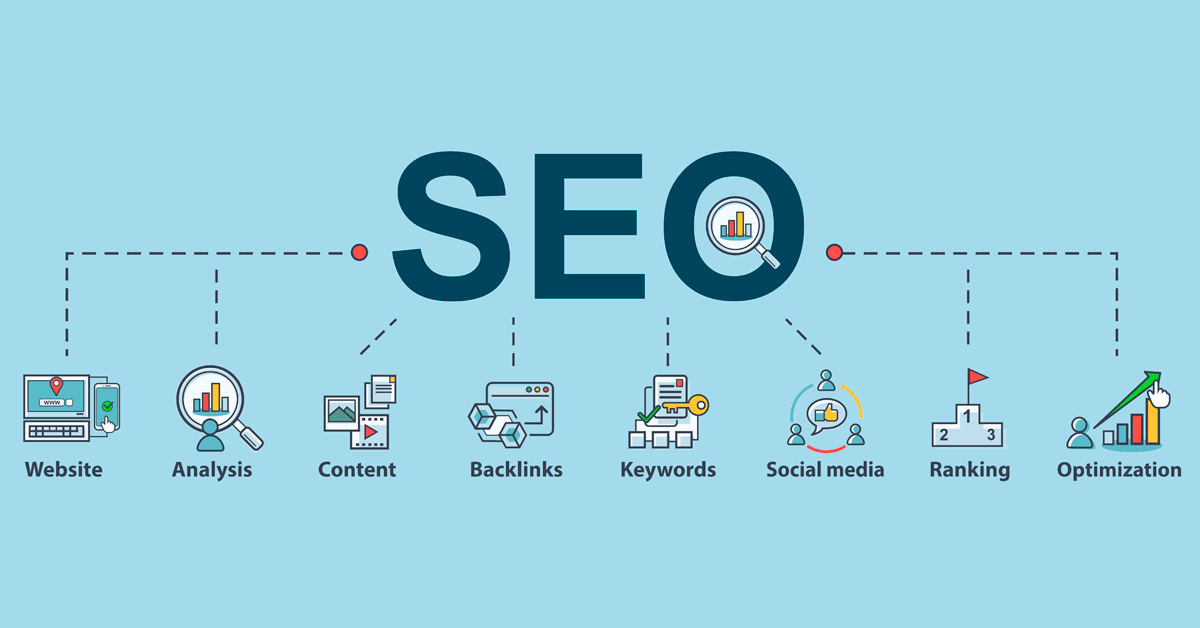
By aligning with search engine algorithms and user intent, SEO ensures that a website attracts more organic traffic, provides a better user experience, and ultimately boosts its credibility and relevance in the competitive online landscape.
With Google owning a massive 83% of the desktop search and 95% of the mobile search market worldwide, it’s no surprise that businesses focus their SEO efforts there. But it’s not just about Google; understanding SEO helps you create a strategy that works across various search platforms.
At its core, SEO is about aligning your website with what search engines are looking for. It involves optimizing everything from your content to technical elements like site speed and mobile usability. The goal? To rank higher in search engine results pages (SERPs) and attract the right kind of visitors; those who are actively searching for what you offer.
For anyone in digital marketing, mastering SEO isn’t just helpful; it’s essential. It’s the key to driving organic traffic, building authority, and standing out in an increasingly competitive digital world.
Understanding how SEO works can significantly impact your online presence, regardless of whether you’re running a blog, an e-commerce site, or a service-based business.
SEO is not about gaming the system; it’s about creating value, building trust, and connecting with the people who matter most—your audience.
How SEO Works in a Nutshell
So, SEO is like this secret sauce that makes your website appear on Google when someone types in something related to your business.
It all starts with crawling. Think of Google as a super curious spider, crawling through all the pages on the internet to see what’s out there. Once it finds your page, it “indexes” it, which means it stores it in this giant database of all the information it’s collected.
Now, here’s where it gets interesting. You’ve got to make sure your site is easy for both Google and people to understand. This means doing keyword research, just figuring out what terms people are typing into Google.
From there, you craft your content; making sure it’s super helpful, relevant, and, well, actually interesting. But that’s not all. Building a network of backlinks, so other reputable sites point to yours, is another big factor.
Think of it like a popularity contest, and those links are votes in your favor. It’s an ongoing process, and there’s no magic formula, but getting it right? Well, that can make all the difference in driving traffic to your site.
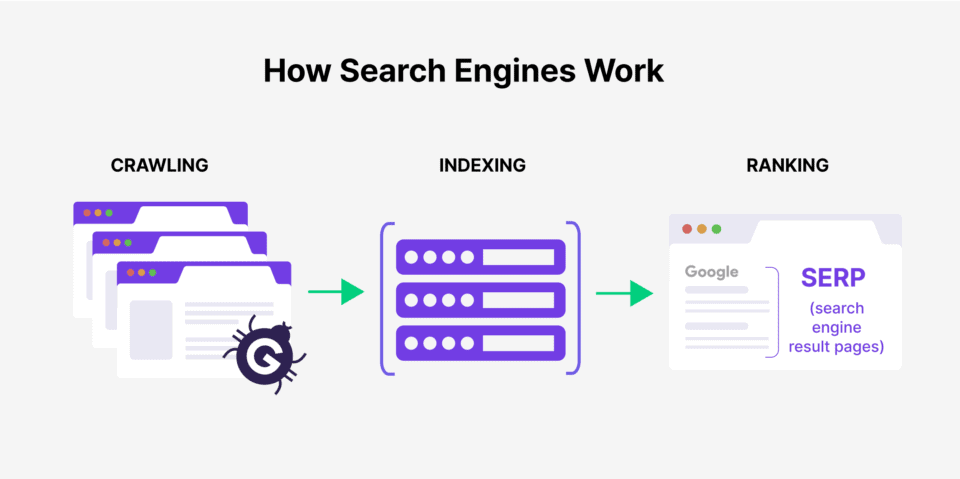
Crawling
The search engine deploys a spider or bot that scours all over the internet from one webpage to another. These bots are like appendages of the platform that gather valuable information about your enterprise and website.
Indexing
Once a website is crawled, the data collected is stored in an enormous index database. It can be perceived as a massive library where every website is filled with information for easy access by users looking for specific information.
Ranking
As we all know, whenever we make a query, the search engine analyzes its index and classifies the pages in order of most relevance to the query; the aim is to retrieve the most pertinent and helpful results first.
The Importance of SEO in Digital Marketing
In today’s world, SEO is more important than ever. It’s a key part of digital marketing because it helps drive organic search traffic. Companies that focus on SEO can greatly improve their online presence and marketing success.
1. Traffic Generation through Organic Search
SEO is crucial for getting organic traffic. As we had said, more than 50% of all website visits come from organic search, showing its big impact.
Organic traffic refers to visitors who arrive at your website through unpaid search results, meaning they are actively searching for information, products, or services. This traffic is highly valuable as it often has genuine intent or interest.
Improving search rankings can also lead to more conversions. This shows how SEO is linked to successful digital marketing.
2. Building Brand Awareness
SEO plays a massive role in putting your brand on the map. When your website is well-optimized, it ranks higher in search results, making it more visible to people actively searching for what you offer.
And let’s be honest, people trust what they see at the top of search results. It gives your brand an air of credibility and authority, like being the go-to expert in your field.
Here’s where it gets even better. SEO doesn’t just improve visibility; it also builds brand awareness over time. Every time your website pops up in searches, more people recognize your name and associate it with value.
With the right strategies, like focusing on local search terms or tailoring content to connect with specific audiences, businesses can expand their reach and strengthen their presence in the market.
At its core, SEO isn’t just about getting clicks – it’s about attracting the right people, building trust, and staying relevant in a competitive digital space. If you want to grow your business and make your brand unforgettable, investing in SEO is the way forward.
3. Enhancing User Experience (UX)
A good user experience is key to success with search engines because users want to be served the fastest and most engaging websites.
Actually, by following all these SEO techniques like Site Speed Optimization, Mobile Responsiveness, Navigation Structure, and Quality Content, you’re enhancing the user experience that isn’t running parallel to improving site ranking but is a part of it instead.
It helps the visitors stay longer on the website, navigate through more than one page, and is likely to lead to a conversion, to buy, subscribe, or do whatever you want the visitor to do. SEO does not only drive traffic but also ensures that users stay and are happy with what you have to offer, ensuring a long-term relationship with your brand.
How Does Search Engine Optimization Differ from SEM and PPC?
Understanding the differences between SEO, SEM (Search Engine Marketing), and PPC (Pay-Per-Click) is key for digital entrepreneurs. SEO improves your site’s organic search ranking. SEM includes paid search, like PPC ads. Knowing how these work together is vital for website traffic.
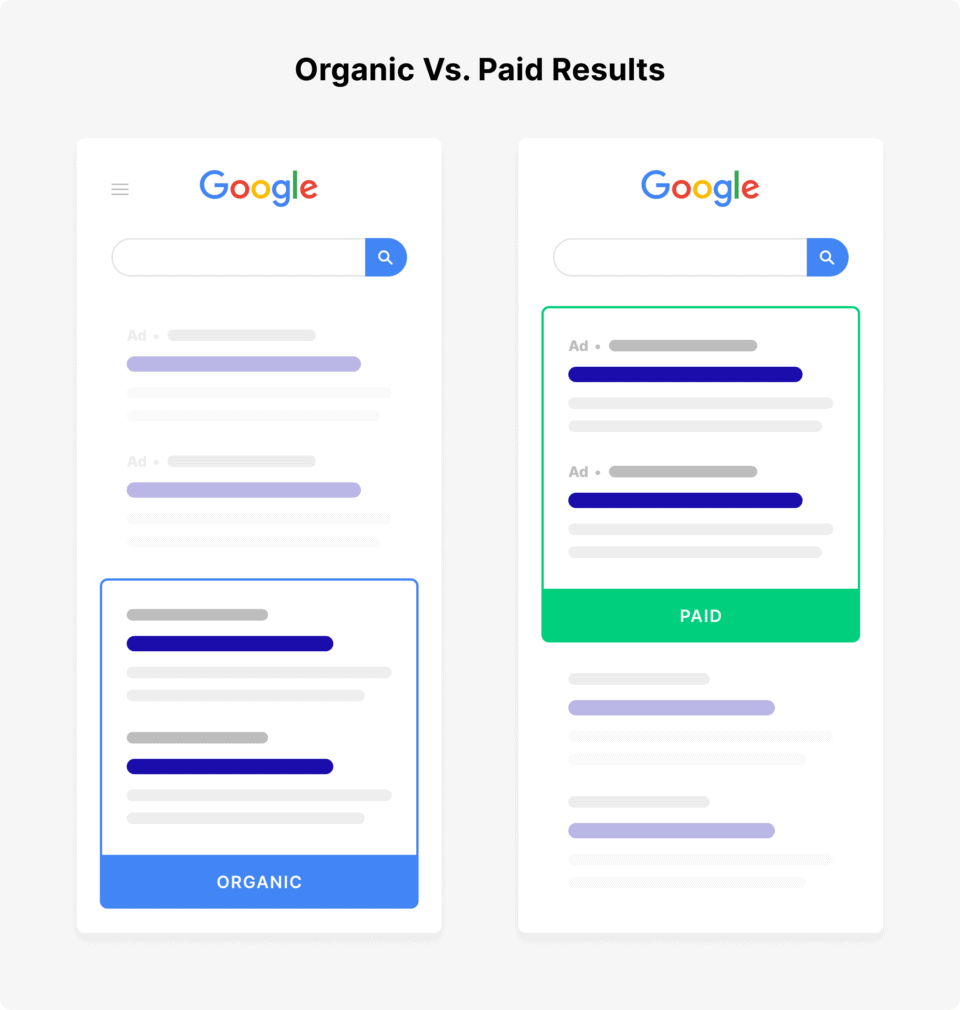
Understanding the Relationship Between SEO, SEM, and PPC
SEO is a big part of search engine marketing, which uses both free and paid methods. Google’s search results have two parts: paid and free. SEO aims for free results, using over 200 ranking signals. SEM, on the other hand, includes paid options like PPC, which can bring quick traffic. SEO, though, takes longer, often 3 to 6 months for results.
PPC ads can show up fast, bringing traffic quickly. This is different from SEO, which takes time but keeps giving value without extra costs.
Since organic search often drives higher-quality traffic, many businesses combine SEO and PPC strategies to maximize their reach and effectiveness in search engine marketing.
Companies with strong organic strategies and paid ads tend to perform better in search results, increasing their visibility.
By leveraging both SEO and PPC, businesses can boost campaign results and ROI. In fact, 41% of marketers report that SEO delivers the best return on investment.
Therefore, understanding how SEO, SEM (Search Engine Marketing), and PPC work together is essential for achieving success in search engine marketing.
Types of SEO and Their Specializations
Understanding the different types of search engine optimization is essential for improving your website’s visibility and achieving better rankings in search engines. Each type focuses on specific aspects of optimization and uses tailored strategies to enhance your overall online presence. Here’s a breakdown of the main types of SEO and their areas of specialization:
1. On-Page SEO
On-page SEO focuses on optimizing individual web pages to rank higher and earn relevant traffic. It involves optimizing content, HTML source code, and elements within the website.
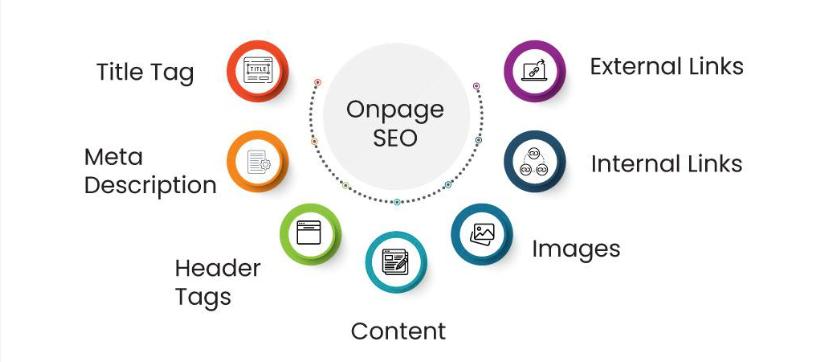
Key Elements:
- Keywords: Using relevant keywords within titles, headings, and even in the content of the web page.
- Title Tags: Writing excellent and keyword-specific titles.
- Meta Descriptions: Writing concise and descriptive summaries for search results.
- Header Tags (H1, H2, H3, etc.): Structuring content for better readability and relevance.
- Content Optimization: Ensuring the content is valuable, unique, and engaging, with proper keyword density.
- Internal Linking: Linking to other pages within the site to improve navigation and authority.
- URL Structure: Creating user-friendly and keyword-rich URLs.
2. Off-Page SEO
Off-page SEO involves activities performed outside your website to improve its authority and rankings. It focuses on building backlinks, reputation, and relationships.
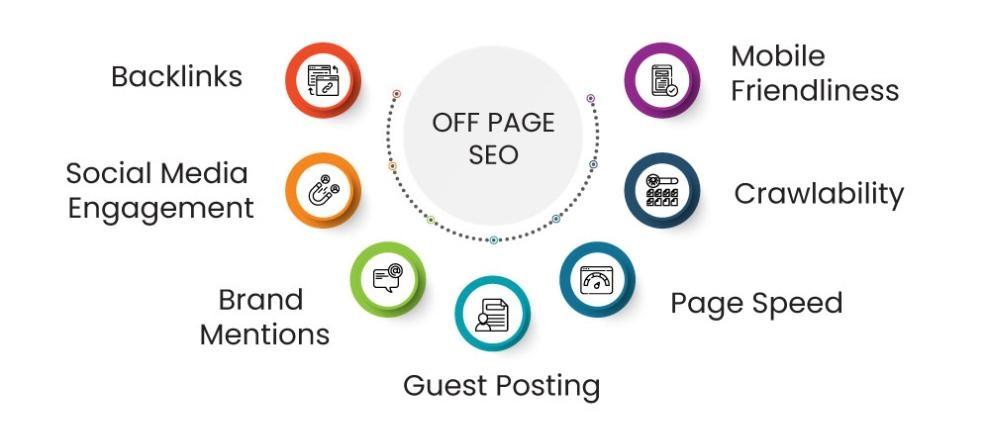
Key Elements:
- Backlink Building: Earning quality links from authoritative websites.
- Social Media Engagement: Promoting content and engaging with users on social platforms.
- Guest Blogging: Writing articles for other sites to gain exposure and backlinks.
- Brand Mentions: Encouraging online mentions of your brand name.
- Influencer Outreach: Collaborating with influencers to promote your content or products.
- Page Speed: Ensuring your site loads quickly for better user experience and SEO rankings.
- Crawlability: Ensure search engines can easily navigate and index your website’s content for better visibility.
- Mobile Friendliness: Optimizing your site for mobile devices to improve user experience and ranking on search engines.
3. Technical SEO
Technical SEO ensures that a website meets the technical requirements of search engines. It improves crawling, indexing, and overall performance.
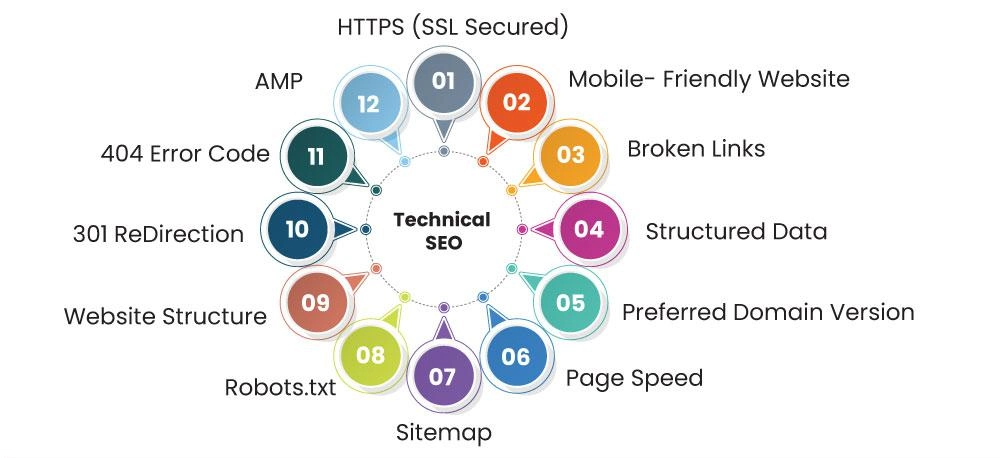
Key Elements:
- HTTPS (SSL Secured): Using SSL certificates to ensure secure and encrypted connections for your website.
- Mobile-Friendly Website: Make sure your website is responsive and works well on all devices.
- Broken Links: Identifying and fixing links that lead to error pages or no longer exist.
- Structured Data: Adding schema markup to help search engines better understand your content.
- Preferred Domain Version: Setting a consistent domain (e.g., www or non-www) to avoid duplicate content.
- Page Speed: Optimizing your website to load quickly and improve user experience.
- Sitemap: Creating and submitting XML sitemaps to guide search engines through your site.
- Robots.txt: Configuring this file to control which parts of your site search engines can crawl.
- Website Structure: Organizing your site’s content logically for better navigation and indexing.
- 301 Redirection: Redirecting outdated URLs to new ones to retain traffic and link equity.
- 404 Error Code: Addressing pages that return “Page Not Found” errors to avoid harming user experience.
- AMP (Accelerated Mobile Pages): Implementing AMP to create fast-loading pages for mobile users.
4. Local SEO
Local SEO is a targeted search engine optimization strategy designed to improve your business’s visibility in local search results on Google. It’s ideal for any business with a physical location or one that provides services within a specific geographical area.
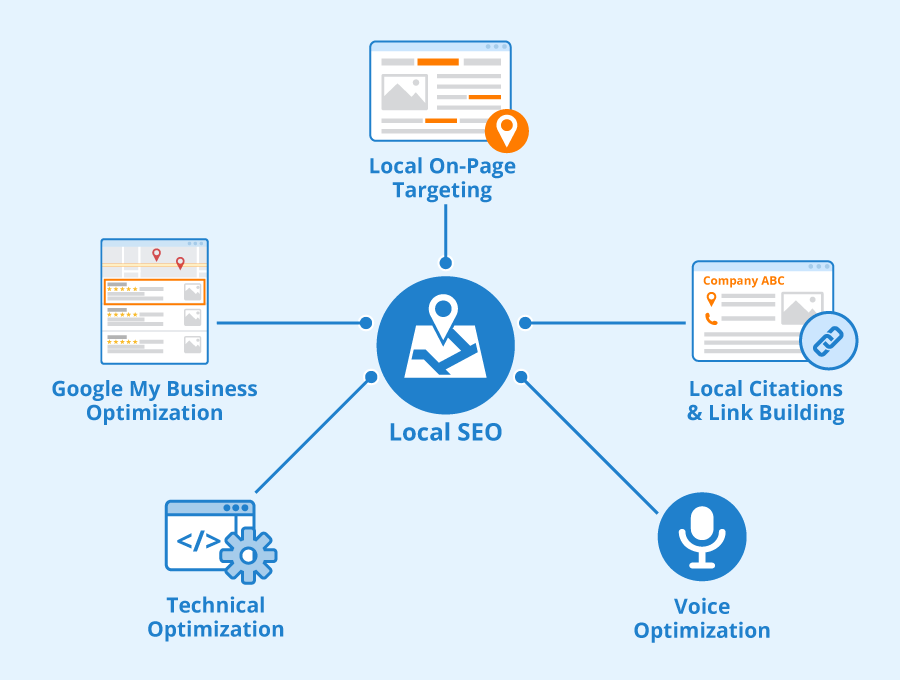
Key Elements:
- Google My Business (GMB): Creating and optimizing a GMB profile.
- NAP Consistency: Ensuring Name, Address, and Phone Number consistency across platforms.
- Local Keywords: Targeting keywords specific to the location.
- Customer Reviews: Encouraging and responding to online reviews.
- Local Listings: Listing the business on local directories like Yelp and Yellow Pages.
Key Components of an Effective SEO Strategy
Building a successful search engine optimization strategy involves focusing on a few core elements that work together to improve your website’s visibility on search engines while keeping your audience engaged.
Each component plays a crucial role in driving organic traffic and ensuring long-term success.
1. Keyword Research and Selection
Everything in SEO starts with understanding what people are searching for. Keyword research helps you identify terms and phrases (keywords) that match user intent. Did you know that 75% of users never scroll past the first page of search results? That’s why selecting the right keywords is so critical.
Focusing on long-tail keywords, specific phrases like “best running shoes for flat feet,” can make a huge difference. These are less competitive and more targeted, which means you’re likely to attract visitors who are genuinely interested in your content or products.
Also Read: How to Drive Organic Traffic to Your Affiliate Links Using Long-Tail Keywords
2. Content Creation and Optimization
Creating content that’s not only informative but also engaging is crucial. By strategically incorporating your chosen keywords into titles, headers, and the body of your content, you improve your chances of ranking higher. Studies suggest that using the right keywords can increase website traffic by about 20%.
Consistency matters, too. Posting fresh, valuable content regularly signals to search engines that your site is active and relevant. Don’t forget to optimize other elements like URLs, meta descriptions, and alt text for images—these small details can significantly improve click-through rates.
3. Link Building Techniques
Backlinks are votes of confidence for your website. The more quality backlinks your site has, the higher its authority becomes. Research shows that sites with strong backlinks are 75% more likely to rank well.
However, not all links are created equal. Focus on earning links from reputable, relevant websites. You can do this by creating content that people naturally want to share or reference.
Fun fact: around 80% of backlinks come from content that’s unique, valuable, or entertaining.
These key elements: targeted keywords, great content, and strong backlinks are the building blocks of an effective SEO strategy. When executed together, they improve your search engine rankings, drive quality traffic, and keep users coming back for more.
Want to boost your website’s authority and rankings? Discover actionable strategies in the Ultimate Guide to Link Building! Start building backlinks and driving traffic today!
Summary:
| Component | Description | Impact |
|---|---|---|
| Keyword Research | Identifying keywords that match user intent | Improves rank potential and visibility |
| Content Optimization | Creating and refining content with targeted keywords | Increases traffic and engagement rates |
| Link Building | Establishing backlinks from reputable sites | Enhances site authority and rankings |
A well-designed, user-focused website contributes to increased dwell time, positively influencing Google’s perception of the site’s relevance and helpfulness.
SEO Evolution and Future Trends
The world of search engine optimization (SEO) is always changing. This is because of new technology and how people use the internet. It’s important to keep up with these changes to stay ahead online.
Impact of AI and Machine Learning
The use of AI has reached an important point in SEO, as the majority of marketers have integrated AI tools into their plans. Search engines like Google now prioritize high-quality, user-focused content.
To meet these standards, content must be original, engaging, and come from reliable sources.
Google’s Search Generative Experience (SGE) highlights the growing emphasis on unique content. In an online world flooded with information, generic content risks being overlooked, making originality more critical than ever.
Mobile First Indexing and User Experience
Mobile-first indexing has shifted the focus to websites optimized for mobile devices. Google gives preference to fast, responsive, and user-friendly sites, rewarding them with higher rankings. This makes responsive design and seamless user experiences essential for maintaining strong visibility in search results.
Implementing SEO: Best Practices to Follow
So, let me state on a strong note that you require SEO as a process systematically and sequentially for enhancing your visits and rankings. Far from an occasional task—it is a recurrent activity in need of repeated interpretation and modification. But when on this task, it can be easier and more effective when using the right tools and resources.
Monitoring and Adjusting Your SEO Strategy
Check on your SEO regularly to know what is producing the results and what side needs improvement. For instance, if you see high bounce rates, then perhaps your website layout is bad or your content does not offer the users what they are expecting when they land on your page, leading to a poor SEO experience.
Google’s main suggestion is to minimize and maximize changes based on data collected. Tools like Search Console offer information on the position of your website on specific keywords, search queries, and other relevant information beneath that, which might signify the website’s problems.
Reviewing and analyzing this data on the regular makes your site maintain that competitive edge and visibility on the search results pages.
Using SEO Tools and Resources
Using search engine optimization tools, such as SEMrush, Ubersuggest, or Ahrefs, will assist in this process. These tools allow you to define suitable keywords, measure your competitors, and find possibilities for improving the position of the strategy.
Backlinking, for example, is crucial in ranking, but the quality of the link is more important than the quantity. Surprisingly, numerous negative backlinks harm the credibility of the site.
Additionally, simple practices like using short, descriptive URLs can improve user experience and make it easier for search engines to understand your content.
Here’s a tip: WordPress plugins like Yoast SEO and Rank Math are excellent tools for optimizing your on-page SEO.
By consistently monitoring performance and utilizing the right tools, you can implement SEO best practices that drive long-term results.
In summary:
| SEO Tool | Main Features | Best For |
|---|---|---|
| Google Analytics | Performance tracking, traffic analysis | Monitoring website performance |
| SEMrush | Keyword research, competitor analysis | Strategy development |
| Ahrefs | Backlink analysis, site audits | Improving site authority |
| Ubersuggest | Keyword suggestions, content ideas, domain overview, and SEO audits | Beginners looking for an affordable and user-friendly SEO tool |
| Yoast SEO/Rank Math | Content optimization, readability scoring | On-page SEO enhancement |
Hiring SEO Services: Is it Worth It?
With the increasing popularity of digital marketing, many businesses are realizing the potential of hiring SEO services.
If you have little or no time for SEO and need professional help to rank well and attract more customers, SEO specialists will be glad to assist you. Indeed, businesses invest up to $497 monthly on SEO to highlight its importance to the achievement of their business goals online.
Benefits of Professional SEO Services
Bringing in an SEO agency can offer numerous benefits. For starters, they can help increase your website’s organic traffic and improve conversion rates, often showing noticeable results within just a few months. This translates into better search engine rankings, more visibility, and ultimately, more opportunities to make sales.
SEO agencies use advanced tools and strategies to analyze your website’s performance and create plans that will make you stand out in a crowded online space.
Best of all, by outsourcing SEO, you free up time to focus on your core business tasks while leaving the technical stuff to the experts.
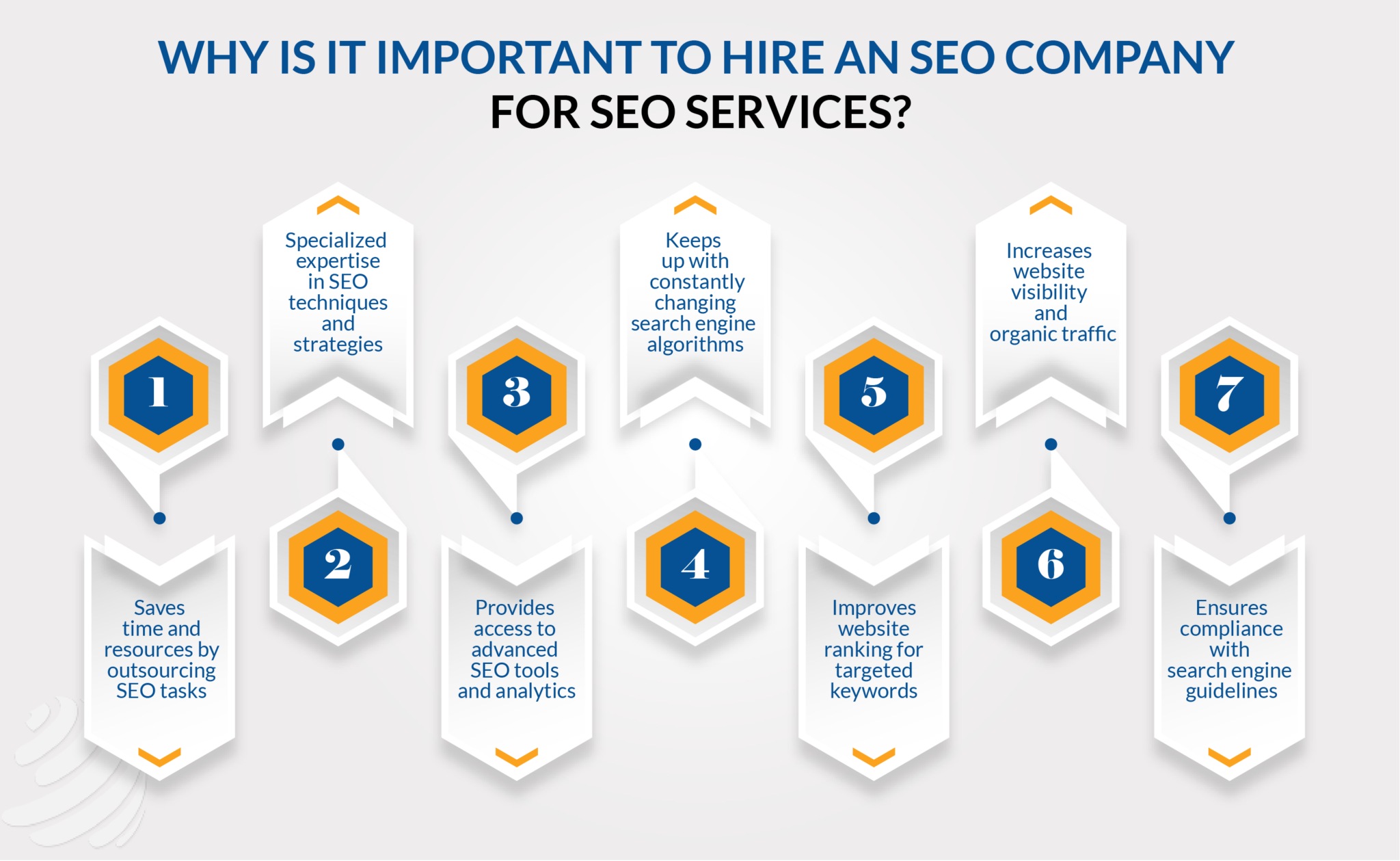
Factors to Consider When Choosing an SEO Agency
Choosing the right SEO agency is a big decision. It’s essential to review their past successes and make sure their approach aligns with your business goals.
If your site requires extensive work, you may need a more advanced SEO strategy to get things moving.
For those on a tight budget, managing SEO on your own is possible, but investing more can lead to better results and the expertise you need to stay ahead.
The agency you select will play a huge role in your digital marketing success, especially since search engine algorithms are always evolving.
| Factor | Consideration |
|---|---|
| Experience and Expertise | Look for agencies with proven success in similar industries. |
| Strategies Offered | Ensure their methods resonate with your business goals and needs. |
| Budget Alignment | Consider agencies that fit within your allocated budget for optimal results. |
| Ongoing Support | Assess whether they provide regular performance analysis and strategy adjustments. |
Hiring professional SEO services can streamline processes and yield higher returns on investment.
Conclusion
Search engine optimization isn’t just some fancy marketing trick, it’s the foundation of helping your online business get noticed and grow.
It’s about more than just pleasing search engines; it’s about creating a better experience for your audience and building a strong, trustworthy brand in today’s crowded digital space.
Here’s the thing: people trust what they see first. With over 25% of users clicking the top search result, being at the top isn’t just nice; it’s essential. It builds confidence in your brand and draws people in, whether they’re just browsing or ready to buy.
To maximize the impact of your SEO efforts, concentrate on straightforward yet effective strategies such as creating a clear call to action and incorporating links to other valuable content on your website. This keeps visitors engaged and makes your site more useful to them, and search engines notice that.
By staying on top of the latest SEO trends and tweaking your approach as needed, you’re setting your business up for lasting success and steady growth.
Frequently Asked Question
What is SEO and why does it matter?
SEO, or Search Engine Optimization, is the process of optimizing your website to improve its visibility on search engines like Google. It matters because higher visibility means more traffic, which can lead to increased brand awareness, engagement, and sales.
How does SEO work?
SEO works by making your website more appealing to search engines. It involves using targeted keywords, creating quality content, and building links. Search engines analyze your site to see if it’s relevant and trustworthy, then rank it accordingly in search results.
What are the main benefits of SEO?
SEO helps drive organic (unpaid) traffic to your site, improves your site’s credibility, and gives you a competitive edge. Plus, it’s cost-effective compared to paid ads and provides long-term results if done correctly.
How long does it take to see results from SEO?
SEO is a long-term strategy. While some improvements may be noticeable within a few weeks, significant results, like higher rankings and increased traffic, often take several months (3-6 months) of consistent effort.
Do I need technical skills to do SEO?
Not necessarily. While some aspects of SEO involve technical elements like coding or site structure, many strategies like keyword research, content creation, and link building can be done without advanced technical knowledge using tools like SEMrush or Yoast.

